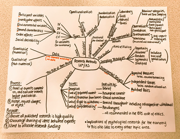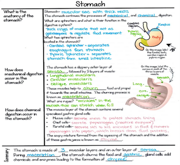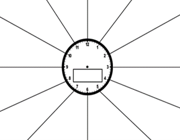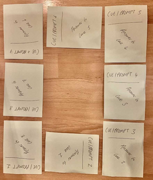Revision
Revision Excellence Guide - Achieving mastery through Unity, Excellence with no Excuses
Revision strategy 1:Fetch, Flip, Check, Repeat (KS3)
 Step 1) Fetch: Students spend a minute memorising key facts from a Knowledge Organiser.
Step 1) Fetch: Students spend a minute memorising key facts from a Knowledge Organiser.
Step 2) Flip: Students set aside their Knowledge Organiser and, without looking back, attempt to write down everything they can remember, relying on effort and memory alone.
Step 3) Check: Students review their work with a different-coloured pen, checking spelling against the Knowledge Organiser, marking corrections directly above errors and noting progress with ticks if accurate.
Step 4) Repeat: Students repeat through the Fetch, Flip, Check, and Repeat process to fully cover their Knowledge Organiser content, marking new repetitions with "//" and using all available space.
Revision strategy 2: Mind mapping
 Step 1) Start with a Central Topic: Write the main subject in the centre of the page.
Step 1) Start with a Central Topic: Write the main subject in the centre of the page.
Step 2) Branch Out Key Ideas: Draw branches from the centre for main ideas or themes.
Step 3) Add Details: Expand each branch with supporting details, keywords, or examples.
Step 4) Use Colours & Images: Different colours and simple images help highlight information and improve memory.
Step 5) Keep It Clear: Keep words and branches short for easy readability and quick review.
Revision strategy 3: Blurting
This is similar to strategy 1, however it encourages pupils to actively recall information first.
 Step 1) Recall & Write: Without looking at notes, students write down everything they can remember about the topic from memory.
Step 1) Recall & Write: Without looking at notes, students write down everything they can remember about the topic from memory.
Step 2) Review & Compare: Open notes or resources to compare what was recalled with the original information, identifying any missing details or errors.
Step 3) Correct & Fill Gaps: Correct mistakes directly on the recall attempt, adding any missed information.
Step 4) Repeat: Repeat the process until all key information can be recalled accurately without reference.
Revision strategy 4: Flash cards
 Step 1) Keep It Simple: Write only key terms or questions on one side and brief answers on the other.
Step 1) Keep It Simple: Write only key terms or questions on one side and brief answers on the other.
Step 2) Prioritise Topics: Start with flashcards on topics that are challenging. This helps students spend more time on weaker areas.
Step 3) Test Frequently: Review the cards regularly, going through them until each one is answered correctly without hesitation. Mix up the order to ensure the brain does not just memorise the sequence.
Revision strategy 5: The Cornell Method
 Step 1) Divide Page: Draw a line to split your page into three sections: a main notes section (right), a cues section (left), and a summary at the bottom.
Step 1) Divide Page: Draw a line to split your page into three sections: a main notes section (right), a cues section (left), and a summary at the bottom.
Step 2) Take Notes: Write key points in the main notes section (right).
Step 3) Add Cues: Afterwards, jot down questions or keywords in the cues section (left) to trigger recall.
Step 4) Summarise: Write a brief summary at the bottom.
Step 5) Review: Cover the notes, use cues to quiz yourself, and refer back only when needed.
Revision strategy 6: Revision clocks
 Step 1) Template: Students take a blank template of a revision clock and decide how to divide their notes into either 12, 6 or 4 sections.
Step 1) Template: Students take a blank template of a revision clock and decide how to divide their notes into either 12, 6 or 4 sections.
Step 2) Timers: Students need to consider how much time they have allocated for revision (ie - 45 minutes) and divide it by how many sections they are using on the revision clock.
Step 3) Note taking: Using a timer, students time themselves to write their notes in the categorised sections of the revision clock.
Revision strategy 7: Domino cards
This method is similar to the flash card technique, but it forces the brain to engage more with the cards.
 Step 1) Create domino's: Obtain some A5 cards and divide each card into 2 using a pen (Ratio 1:2)
Step 1) Create domino's: Obtain some A5 cards and divide each card into 2 using a pen (Ratio 1:2)
Step 2) Arrange your cards in a vertical line
Step 3) Write your questions on the left side
Step 4) Answer the questions on the right hand side of the card below
Step 5) Shuffle the cards and Re-Arrange the cards in a square loop – so that each cue / question matches the correct information
Step 7) Repeat every couple of days and see if your time becomes quicker
Revision strategy 8: Timed Practice
- Step 1) Set Clear Goals: Decide what you want to practise (e.g., essay writing, maths problems) and set a time limit that challenges but doesn’t overwhelm.
- Step 2) Simulate Test Conditions: Work in a quiet space without distractions, and avoid checking notes. This builds focus and exam resilience.
- Step 3) Check Progress: After each session, review accuracy and note areas needing improvement. Aim to gradually reduce time taken
- Step 4) Review Mistakes: Learn from errors, adjust time limits as needed.
- Step 5) Repeat Often: Practise consistently to build speed, confidence, and familiarity with exam questions.

